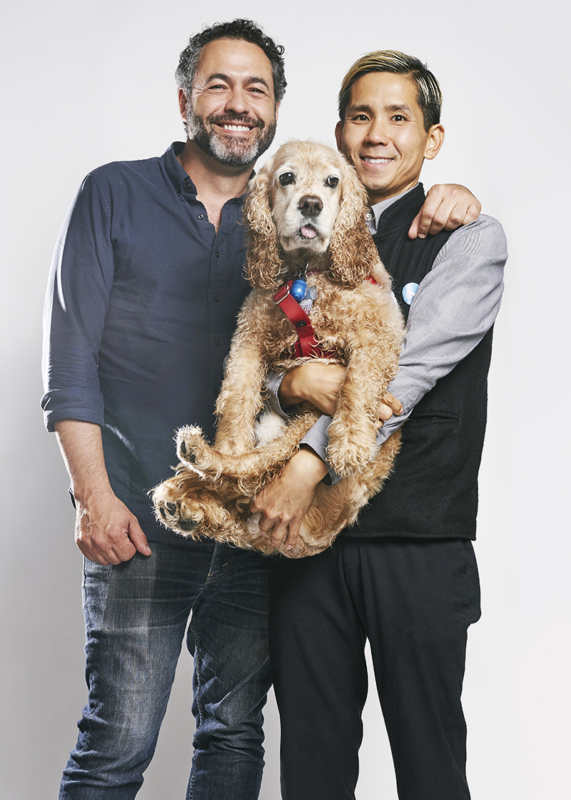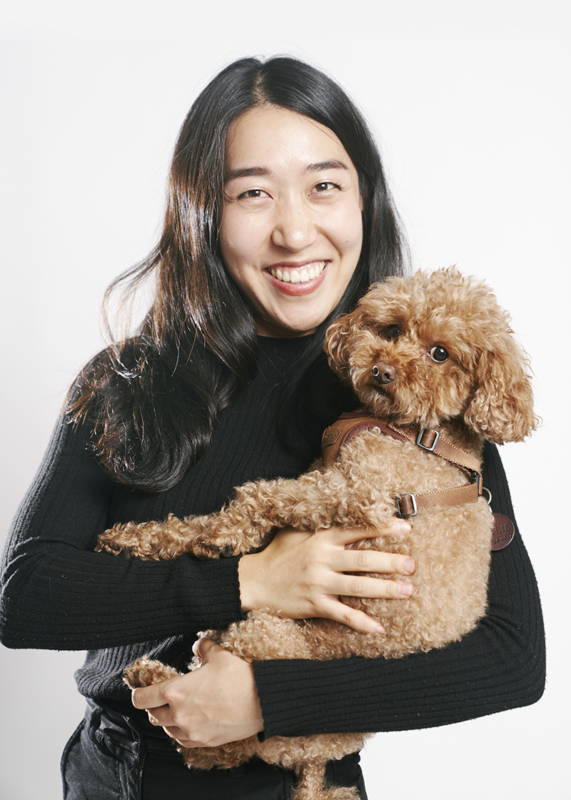An increasing number of companies are going dog-friendly—something many dog people consider an office perk. The truth is, dogs are good for business: They boost employee well-being, relieve stress, and even promote social interactions between staff. There are, however, some undeniable inconveniences that come with having pups in the workplace: There’s the possibility of “accidents,” loud barking, unwanted marking, and the potential that two or more office dogs won’t vibe with one another.
At a recent dog adoption and social event at WeWork 205 Hudson St in Manhattan, photographer Winnie Au partnered with WeWork, dog-centric magazine Four & Sons, and Animal Haven Shelter to give people a chance to mingle among art, adoptable pooches, and good company. Magazines, merchandise, and prints from Au’s “Cone of Shame” series were available for purchase, with all proceeds benefiting Animal Haven.
Because many WeWork spaces, including 205 Hudson St, are dog-friendly, many guests brought their four-legged pals to join in on the fun. “Having members’ dogs share the space with us is a guaranteed way to enhance the member experience,” says Jane Yoon, a community associate at the building. “A jingling leash sends heads turning to locate the furry friend. Members in passing, working at hot desks, or walking to the espresso machine always make sure to greet them with a treat or a head rub, which is nice to see as a community member.” To get some insight about proper etiquette for bringing dogs to work, WeWork spoke with several guests at the event.
1. Come prepared
Your dog deserves to feel comfortable when they accompany you to the office. For some pooches, a dog bed and a bowl of water is enough to get their tail wagging, while others may benefit from a toy, treats, and a part-time belly-rubber. Real estate broker Christophe Tedjasukmana says his company has a pet-friendly policy, and all dogs are welcome as long as they’re in control. “I keep Toby on a short leash at my desk,” he says, adding that he always packs treats in case people are interested in getting to know Toby, as his pup is much more receptive to strangers if they have something delicious to offer him.

While Toby, a six-year-old rescue, is mostly well behaved, he does experience some separation anxiety when apart from his owner, so Tedjasukmana will sometimes bring Toby to open houses. It’s mutually beneficial: “Toby seals the deal,” he says.
2. Beware of plants
If your dog has a tendency to mark their territory, beware of large office plants, advises Minji Kim, a creative strategist who takes her curly pup Amélie to the office virtually every day. “Mostly male dogs have peed on plants [in my office] because they’re marking,” she says. Accidents happen, but it’s best to know where those desirable fauna are located in the office, and maybe stick to another side of the building when your beloved furbaby is joining you.

3. Befriend other dog people
“It takes a village,” Kim says, joking about bringing her dog to work. But there’s a true benefit in getting to know other people in your office in case you need help. Kim’s dog Amélie is “obsessed” with one of her coworkers in particular, so she always feels comfortable leaving Amélie under his eye if she needs to run out for a meeting or is having an especially busy day. And because many of Kim’s colleagues bring their dogs to the office, the owners have created an unspoken system to make sure everyone’s being cared for. “It happens a lot—with me and other team members. They’ll ask me to watch their dog for a little, or I’ll offer to take their dog on a walk if I’m going with Amélie anyway,” she says.

It’s crucial to have some in-house pet sitters you can rely on, because no dog should ever be left alone, says HR business partner Van Le. It’s especially important to have someone you trust, he explains, because otherwise people may not be honest about the dog’s behavior. “People are afraid they might come off as judgy,” he says. For Le, sharing his little guy Marshawn with his coworkers is one of the best parts of bringing him to work: “They get to see that part of you, and [having a dog] breaks the ice and makes everything a little bit easier.”
4. Know your dog
As much as you may want to bring your pet to work (and everywhere in between), it’s important to think about how they’ll take to the various aspects of office life. “I luckily have two very chill dogs,” says wedding photographer Karen Seifert, who recently adopted her puppy Bort. “They sit on the couch, look out the window, and sleep.” If your dog tends to have a ton of energy, plan to take them out for an exercise session before the start of the workday in order to tire them out. If that’s not enough, you might have to accept the fact that your dog’s demeanor is not suited for the corporate world.

“Every dog owner should know their dog,” Kim says. “If you know your dog doesn’t do well with a lot of other dogs, maybe ease them into it, or be honest with yourself that it’s not a great environment.”
If you decide that your dog doesn’t make a great addition to the office, just remember how happy they’ll be to see you when you get home.
Kate Bratskeir is a writer for WeWork’s Ideas by We, focusing on sustainability and workplace psychology. Previously, she was a senior editor at Mic and HuffPost. Her work has appeared in New York magazine, Health, Travel & Leisure, Women’s Health, and more.







